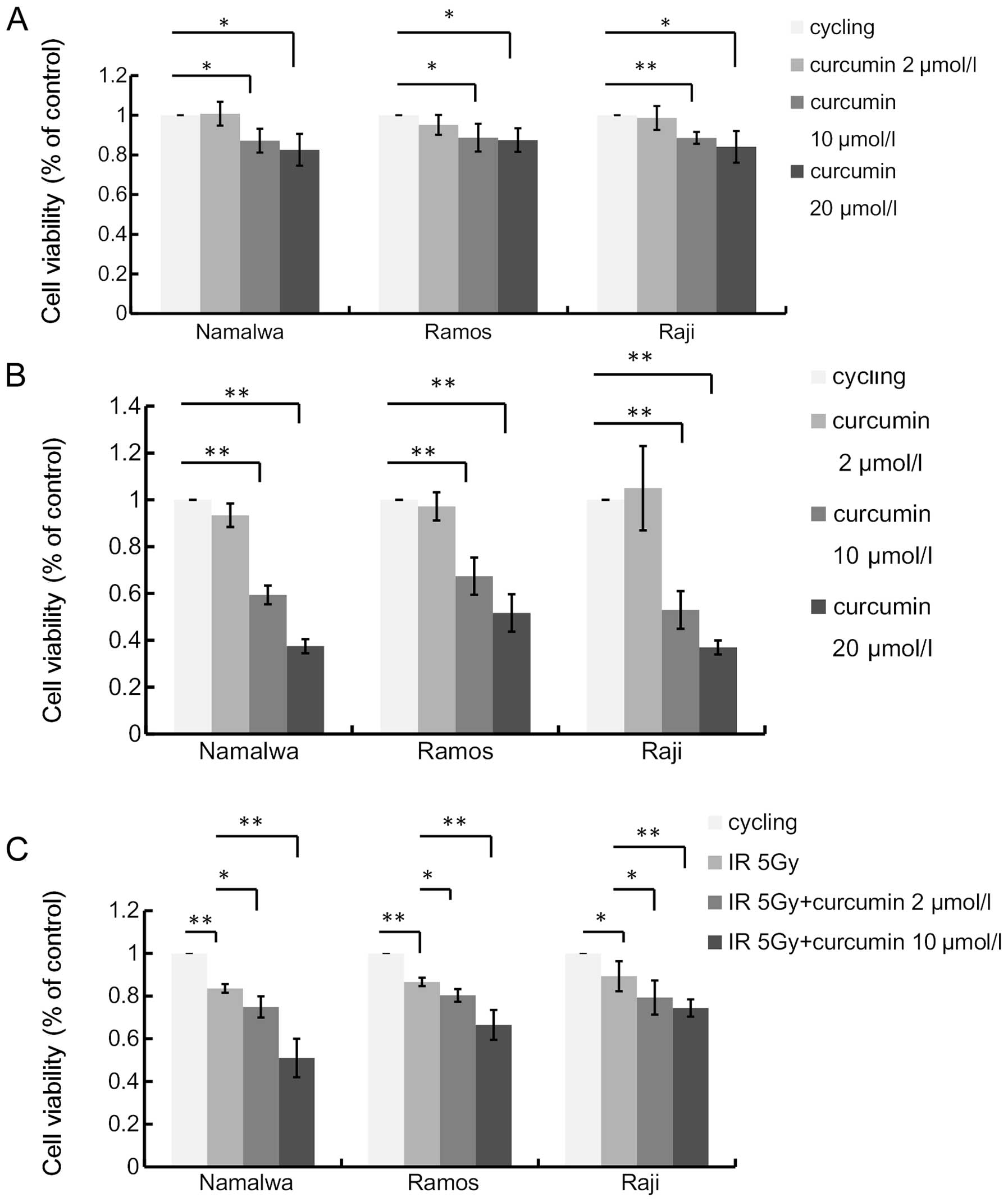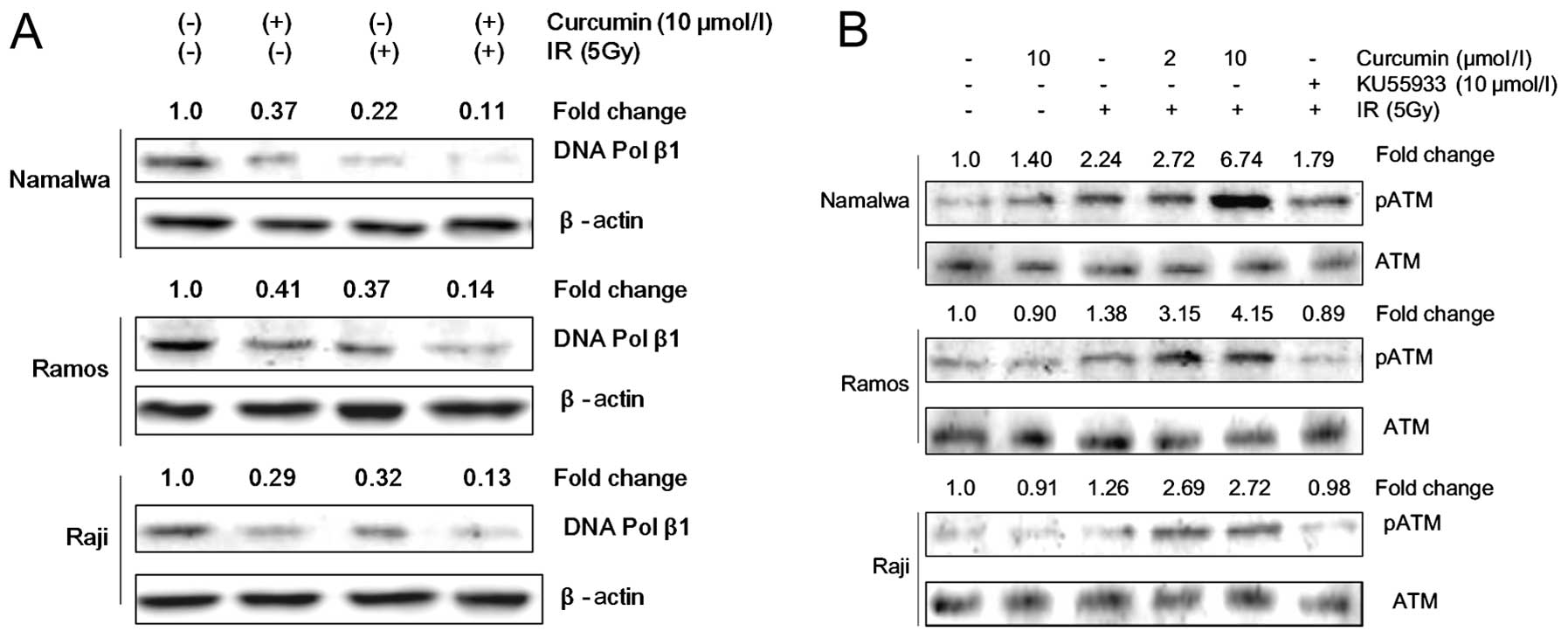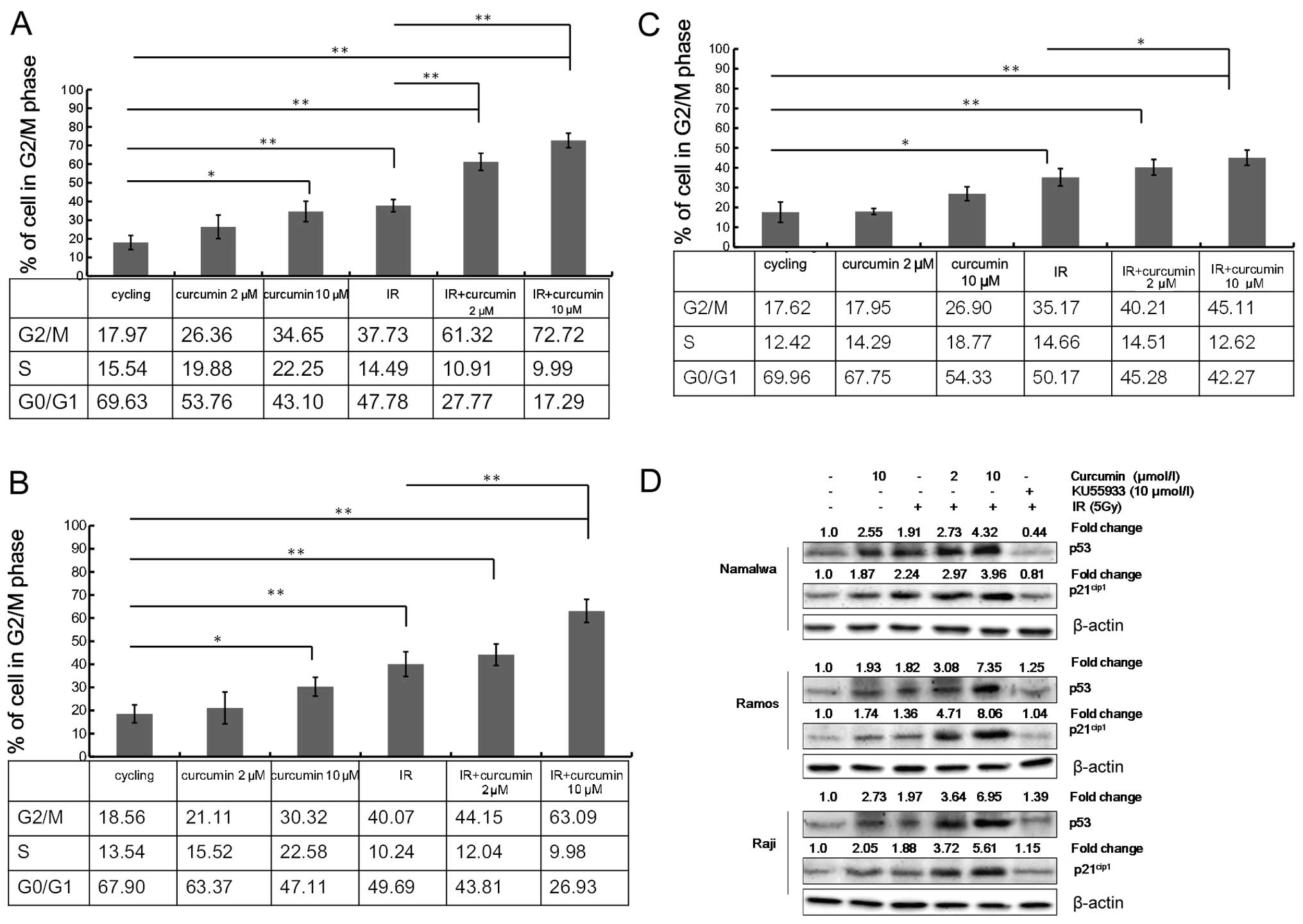|
1
|
Bulut E, Bekcioglu B, Gunhan O and Sener
I: Diffuse large B-cell lymphoma with oral manifestations. J
Craniofac Surg. 22:1144–1147. 2011. View Article : Google Scholar : PubMed/NCBI
|
|
2
|
Hainsworth JD: Monoclonal antibody therapy
in lymphoid malignancies. Oncologist. 5:376–384. 2000. View Article : Google Scholar : PubMed/NCBI
|
|
3
|
Li L, Aggarwal BB, Shishodia S, Abbruzzese
J and Kurzrock R: Nuclear factor-kappaB and IkappaB kinase are
constitutively active in human pancreatic cells, and their
down-regulation by curcumin (diferuloylmethane) is associated with
the suppression of proliferation and the induction of apoptosis.
Cancer. 101:2351–2362. 2004. View Article : Google Scholar
|
|
4
|
Aggarwal BB, Banerjee S, Bharadwaj U, Sung
B, Shishodia S and Sethi G: Curcumin induces the degradation of
cyclin E expression through ubiquitin-dependent pathway and
up-regulates cyclin-dependent kinase inhibitors p21 and p27 in
multiple human tumor cell lines. Biochem Pharmacol. 73:1024–1032.
2007. View Article : Google Scholar
|
|
5
|
Liu HL, Chen Y, Cui GH and Zhou JF:
Curcumin, a potent anti-tumor reagent, is a novel histone
deacetylase inhibitor regulating B-NHL cell line Raji
proliferation. Acta Pharmacol Sin. 26:603–609. 2005. View Article : Google Scholar : PubMed/NCBI
|
|
6
|
Alaikov T, Konstantinov SM, Tzanova T,
Dinev K, Topashka-Ancheva M and Berger MR: Antineoplastic and
anticlastogenic properties of curcumin. Ann NY Acad Sci.
1095:355–370. 2007. View Article : Google Scholar : PubMed/NCBI
|
|
7
|
Syng-Ai C, Kumari AL and Khar A: Effect of
curcumin on normal and tumor cells: role of glutathione and bcl-2.
Mol Cancer Ther. 3:1101–1108. 2004.PubMed/NCBI
|
|
8
|
Khafif A, Lev-Ari S, Vexler A, et al:
Curcumin: a potential radio-enhancer in head and neck cancer.
Laryngoscope. 119:2019–2026. 2009. View Article : Google Scholar : PubMed/NCBI
|
|
9
|
Chendil D, Ranga RS, Meigooni D,
Sathishkumar S and Ahmed MM: Curcumin confers radiosensitizing
effect in prostate cancer cell line PC-3. Oncogene. 23:1599–1607.
2004. View Article : Google Scholar : PubMed/NCBI
|
|
10
|
Sandur SK, Deorukhkar A, Pandey MK, et al:
Curcumin modulates the radiosensitivity of colorectal cancer cells
by suppressing constitutive and inducible NF-kappaB activity. Int J
Radiat Oncol Biol Phys. 75:534–542. 2009. View Article : Google Scholar : PubMed/NCBI
|
|
11
|
Yallapu MM, Maher DM, Sundram V, Bell MC,
Jaggi M and Chauhan SC: Curcumin induces chemo/radio-sensitization
in ovarian cancer cells and curcumin nanoparticles inhibit ovarian
cancer cell growth. J Ovarian Res. 3:112010. View Article : Google Scholar : PubMed/NCBI
|
|
12
|
Javvadi P, Segan AT, Tuttle SW and
Koumenis C: The chemopreventive agent curcumin is a potent
radiosensitizer of human cervical tumor cells via increased
reactive oxygen species production and overactivation of the
mitogen-activated protein kinase pathway. Mol Pharmacol.
73:1491–1501. 2008. View Article : Google Scholar
|
|
13
|
Qiao Q, Jiang Y and Li G: Curcumin
improves the antitumor effect of X-ray irradiation by blocking the
NF-kappaB pathway: an in vitro study of lymphoma. Anticancer Drugs.
23:597–605. 2012. View Article : Google Scholar : PubMed/NCBI
|
|
14
|
Anand P, Sung B, Kunnumakkara AB,
Rajasekharan KN and Aggarwal BB: Suppression of pro-inflammatory
and proliferative pathways by diferuloylmethane (curcumin) and its
analogues dibenzoylmethane, dibenzoylpropane, and
dibenzylideneacetone: role of Michael acceptors and Michael donors.
Biochem Pharmacol. 82:1901–1909. 2011. View Article : Google Scholar
|
|
15
|
Wang Y, Rishi AK, Wu W, et al: Curcumin
suppresses growth of mesothelioma cells in vitro and in vivo, in
part, by stimulating apoptosis. Mol Cell Biochem. 357:83–94. 2011.
View Article : Google Scholar : PubMed/NCBI
|
|
16
|
Lev-Ari S, Starr A, Vexler A, et al:
Inhibition of pancreatic and lung adenocarcinoma cell survival by
curcumin is associated with increased apoptosis, down-regulation of
COX-2 and EGFR and inhibition of Erk1/2 activity. Anticancer Res.
26:4423–4430. 2006.PubMed/NCBI
|
|
17
|
Liao S, Xia J, Chen Z, et al: Inhibitory
effect of curcumin on oral carcinoma CAL-27 cells via suppression
of Notch-1 and NF-kappaB signaling pathways. J Cell Biochem.
112:1055–1065. 2011. View Article : Google Scholar : PubMed/NCBI
|
|
18
|
Binion DG, Otterson MF and Rafiee P:
Curcumin inhibits VEGF-mediated angiogenesis in human intestinal
microvascular endothelial cells through COX-2 and MAPK inhibition.
Gut. 57:1509–1517. 2008. View Article : Google Scholar : PubMed/NCBI
|
|
19
|
Huang S and Houghton PJ: Targeting mTOR
signaling for cancer therapy. Curr Opin Pharmacol. 3:371–377. 2003.
View Article : Google Scholar
|
|
20
|
Li R, Wang R, Zhai R and Dong Z: Targeted
inhibition of mammalian target of rapamycin (mTOR) signaling
pathway inhibits proliferation and induces apoptosis of laryngeal
carcinoma cells in vitro. Tumori. 97:781–786. 2011.PubMed/NCBI
|
|
21
|
Jazirehi AR, Wenn PB and Damavand M:
Therapeutic implications of targeting the PI3Kinase/AKT/mTOR
signaling module in melanoma therapy. Am J Cancer Res. 2:178–191.
2012.PubMed/NCBI
|
|
22
|
Chakraborty S, Mohiyuddin SM, Gopinath KS
and Kumar A: Involvement of TSC genes and differential expression
of other members of the mTOR signaling pathway in oral squamous
cell carcinoma. BMC Cancer. 8:1632008. View Article : Google Scholar : PubMed/NCBI
|
|
23
|
Darb-Esfahani S, Faggad A, Noske A, et al:
Phospho-mTOR and phospho-4EBP1 in endometrial adenocarcinoma:
association with stage and grade in vivo and link with response to
rapamycin treatment in vitro. J Cancer Res Clin Oncol. 135:933–941.
2009. View Article : Google Scholar : PubMed/NCBI
|
|
24
|
Ekstrand AI, Jonsson M, Lindblom A, Borg A
and Nilbert M: Frequent alterations of the PI3K/AKT/mTOR pathways
in hereditary nonpolyposis colorectal cancer. Fam Cancer.
9:125–129. 2010. View Article : Google Scholar : PubMed/NCBI
|
|
25
|
Kuo SH, Hsu CH, Chen LT, et al: Lack of
compensatory pAKT activation and eIF4E phosphorylation of lymphoma
cells towards mTOR inhibitor, RAD001. Eur J Cancer. 47:1244–1257.
2011. View Article : Google Scholar : PubMed/NCBI
|
|
26
|
Beevers CS, Chen L, Liu L, Luo Y, Webster
NJ and Huang S: Curcumin disrupts the mammalian target of
rapamycin-raptor complex. Cancer Res. 69:1000–1008. 2009.
View Article : Google Scholar : PubMed/NCBI
|
|
27
|
Scapagnini G, Foresti R, Calabrese V,
Giuffrida Stella AM, Green CJ and Motterlini R: Caffeic acid
phenethyl ester and curcumin: a novel class of heme oxygenase-1
inducers. Mol Pharmacol. 61:554–561. 2002. View Article : Google Scholar : PubMed/NCBI
|
|
28
|
Kumar R and Atlas I: Interferon alpha
induces the expression of retinoblastoma gene product in human
Burkitt lymphoma Daudi cells: role in growth regulation. Proc Natl
Acad Sci USA. 89:6599–6603. 1992. View Article : Google Scholar : PubMed/NCBI
|
|
29
|
Neijenhuis S, Verwijs-Janssen M, van den
Broek LJ, Begg AC and Vens C: Targeted radiosensitization of cells
expressing truncated DNA polymerase β. Cancer Res. 70:8706–8714.
2010.PubMed/NCBI
|
|
30
|
Shrivastav M, Miller CA, De Haro LP, et
al: DNA-PKcs and ATM co-regulate DNA double-strand break repair.
DNA Repair (Amst). 8:920–929. 2009. View Article : Google Scholar : PubMed/NCBI
|
|
31
|
Lukas C, Bartkova J, Latella L, et al: DNA
damage-activated kinase Chk2 is independent of proliferation or
differentiation yet correlates with tissue biology. Cancer Res.
61:4990–4993. 2001.PubMed/NCBI
|
|
32
|
Huang M, Miao ZH, Zhu H, Cai YJ, Lu W and
Ding J: Chk1 and Chk2 are differentially involved in homologous
recombination repair and cell cycle arrest in response to DNA
double-strand breaks induced by camptothecins. Mol Cancer Ther.
7:1440–1449. 2008. View Article : Google Scholar
|
|
33
|
Hickson I, Zhao Y, Richardson CJ, et al:
Identification and characterization of a novel and specific
inhibitor of the ataxia-telangiectasia mutated kinase ATM. Cancer
Res. 64:9152–9159. 2004. View Article : Google Scholar : PubMed/NCBI
|
|
34
|
Rashid A, Liu C, Sanli T, et al:
Resveratrol enhances prostate cancer cell response to ionizing
radiation. Modulation of the AMPK, Akt and mTOR pathways. Radiat
Oncol. 6:1442011. View Article : Google Scholar : PubMed/NCBI
|
|
35
|
Kunnumakkara AB, Anand P and Aggarwal BB:
Curcumin inhibits proliferation, invasion, angiogenesis and
metastasis of different cancers through interaction with multiple
cell signaling proteins. Cancer Lett. 269:199–225. 2008. View Article : Google Scholar
|
|
36
|
Sahu RP, Batra S and Srivastava SK:
Activation of ATM/Chk1 by curcumin causes cell cycle arrest and
apoptosis in human pancreatic cancer cells. Br J Cancer.
100:1425–1433. 2009. View Article : Google Scholar : PubMed/NCBI
|
|
37
|
Taylor WR and Stark GR: Regulation of the
G2/M transition by p53. Oncogene. 20:1803–1815. 2001. View Article : Google Scholar : PubMed/NCBI
|
|
38
|
Calaf GM, Echiburu-Chau C, Wen G, Balajee
AS and Roy D: Effect of curcumin on irradiated and
estrogen-transformed human breast cell lines. Int J Oncol.
40:436–442. 2012.PubMed/NCBI
|
|
39
|
Lin YC, Chen HW, Kuo YC, Chang YF, Lee YJ
and Hwang JJ: Therapeutic efficacy evaluation of curcumin on human
oral squamous cell carcinoma xenograft using multimodalities of
molecular imaging. Am J Chin Med. 38:343–358. 2010. View Article : Google Scholar : PubMed/NCBI
|
|
40
|
Moragoda L, Jaszewski R and Majumdar AP:
Curcumin induced modulation of cell cycle and apoptosis in gastric
and colon cancer cells. Anticancer Res. 21:873–878. 2001.PubMed/NCBI
|
|
41
|
Liu E, Wu J, Cao W, et al: Curcumin
induces G2/M cell cycle arrest in a p53-dependent manner and
upregulates ING4 expression in human glioma. J Neurooncol.
85:263–270. 2007. View Article : Google Scholar : PubMed/NCBI
|
|
42
|
Schiewer MJ, Den R, Hoang DT, et al: mTOR
is a selective effector of the radiation therapy response in
androgen receptor-positive prostate cancer. Endocr Relat Cancer.
19:1–12. 2012. View Article : Google Scholar : PubMed/NCBI
|
|
43
|
Johnson SM, Gulhati P, Arrieta I, et al:
Curcumin inhibits proliferation of colorectal carcinoma by
modulating Akt/mTOR signaling. Anticancer Res. 29:3185–3190.
2009.PubMed/NCBI
|
|
44
|
Beevers CS, Li F, Liu L and Huang S:
Curcumin inhibits the mammalian target of rapamycin-mediated
signaling pathways in cancer cells. Int J Cancer. 119:757–764.
2006. View Article : Google Scholar : PubMed/NCBI
|













